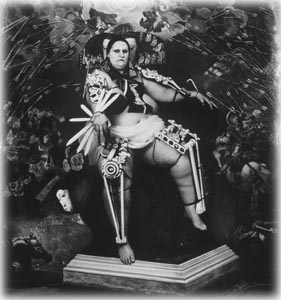A History of Truth
Photographer Joel-Peter Witkin borrows from the history of painting to reveal the potential of horror and suffering in the human condition
At first glance, photographer Joel-Peter Witkin's most recent works, now on exhibit at the Fraenkel Gallery, may appear somewhat repetitious. Anyone who has followed the tempest over NEA funding of scandalous artists such as Robert Mapplethorpe and Andres Serrano will be familiar with Witkin's images of deformed, scarred and tortured bodies. On closer examination, however, it is evident that Witkin, rather than seeking merely to shock, is passionately interested in the lives of the "abnormal" and "grotesque" people he photographs.
Witkin deliberately references famous paintings in order to exalt his subjects by setting them in a "high-art" context, sometimes scratching or yellowing his pieces to make them appear old. Faded beauty, ruined lives, monsters, marvels and half-humans abound throughout art history, and Witkin evokes the voices of past artists to recover the ineffable, disturbing and extraordinary in the present.
Although Witkin is often criticized for his excessive borrowing of historical and mythological figures and symbols, he is driven by an obsession to reveal the potential of horror and suffering in the human condition. His arresting images show us our powerlessness in the face of madness, lust, disease and death.
Witkin's fascination with "freaks"--from giantesses, midgets and hermaphrodites to Siamese twins and the elephant man--has spurred violent reactions for many years. Treading a fine line between the rational and the vulgar, Witkin imposes overwhelming emotions on the spectator. The initial reaction to his display of the disfigured, the deceased and the deranged is often disgust, but for those who understand Witkin's determination to find wonder and beauty in people whom society has deemed wretched and frightening, his photographs are often extraordinary.
His first assignment was at the age of 16, when he photographed a three-legged man, a dwarf called "The Chicken Lady" and a hermaphrodite at Coney Island for his brother, who was working on a painting that incorporated freaks. Later, Witkin enlisted in the army and served as a combat photographer in Europe and Vietnam; in 1986, he received a master of fine arts degree in photography from the University of New Mexico.
At the Fraenkel Gallery's opening reception last month, Witkin talked about two of his newest photographs. The subject of Abundance (1997) is a woman from Prague without arms and legs who was abandoned by her mother at birth and lived in an apartment with a very large dog. In Witkin's portrait, the woman sits in an urn, her head adorned with flowers, fruit and pearls--an icon of nurturing. Female King (1997) poses on a throne a 400-pound, 6-foot-2-inch woman who, according to Witkin, was strong but gentle and insecure.
He explained that he wanted to show the women as possessing great power and courage. His fascination with the lives of those who live at the margins is not intended to reveal what the individual subject chooses to hide but instead to make the hidden qualities more meaningful.
Regardless of Witkin's habit of borrowing from the history of painting, his work is just as gripping as always. Through his methodology and consistency, he reminds us that a lingering practice is not necessarily a bad trait, but rather a ritual that grows deeper and more meaningful with time.
Copyright © Metro Publishing Inc. Maintained by Boulevards New Media.

High and Mighty: Photographer Joel-Peter Witkin borrows
from 19th-century painter James Ensor and poses a
400-pound woman for 'Female King' (1997).
At Fraenkel Gallery, 49 Geary St., fourth floor, through Oct. 11; Tue.-Fri. 10:30am-5:30pm Sat. 11am-5pm; 415/981-2661.
From the October 1997 issue of the Metropolitan.
![[MetroActive Arts]](/arts/gifs/art468.gif)